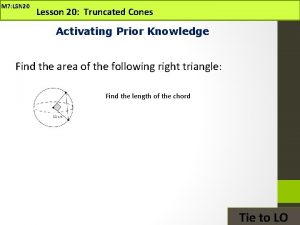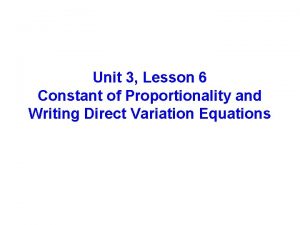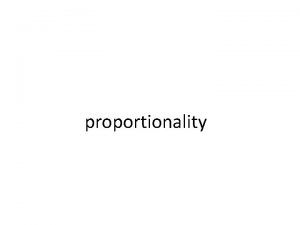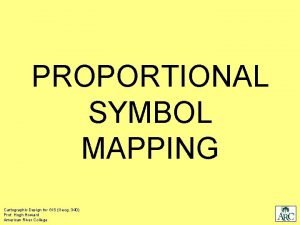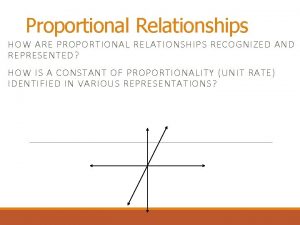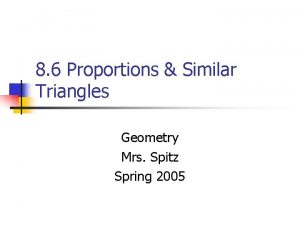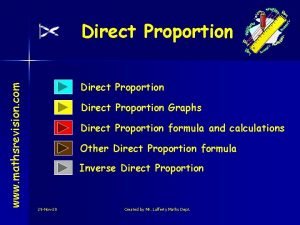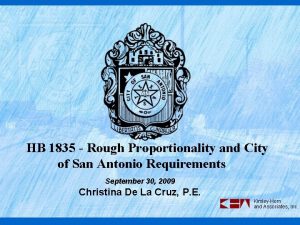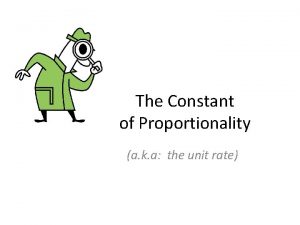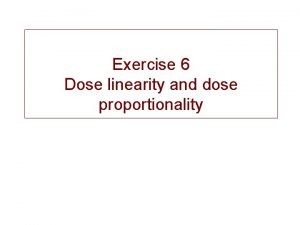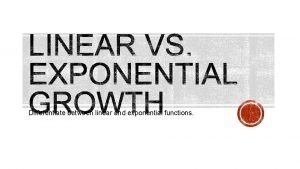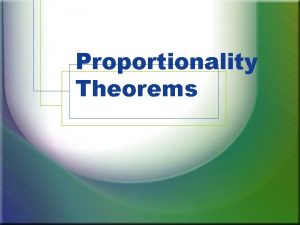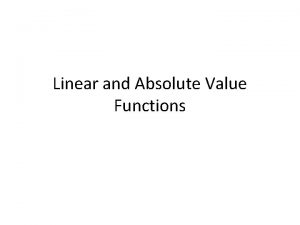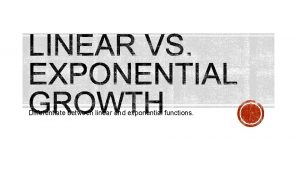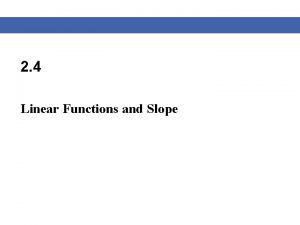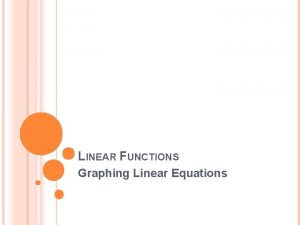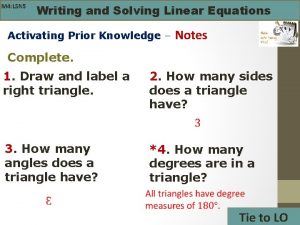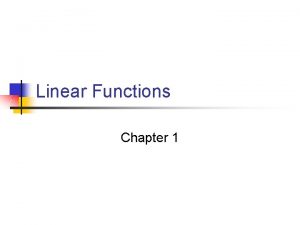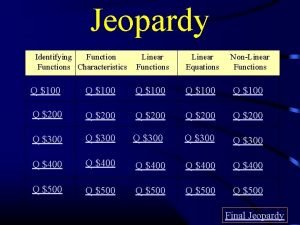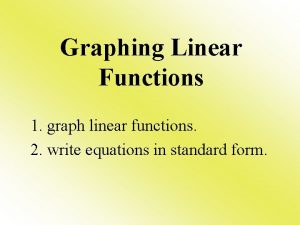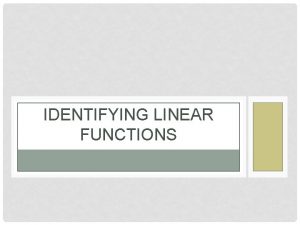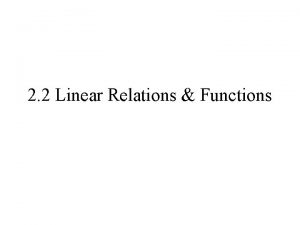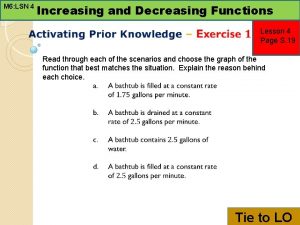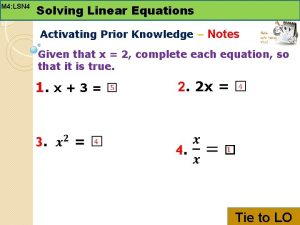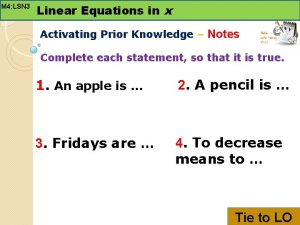M 5 LSN 3 Linear Functions and Proportionality





























- Slides: 29

M 5: LSN 3 Linear Functions and Proportionality Activating Prior Knowledge – Complete the tables. 1. x y 1 2. x y -5 1 2 5 3 15 3. x y 1 1 -4 2 6 2 2 3 11 3 8 Tie to LO

Learning Objective Today, we will relate constant speed and proportional relationships to linear functions using information from a table. CFU

M 5: LSN 3 Linear Functions and Proportionality Concept Development - Ex 1 Module Page 12 In the last lesson, we looked at several tables of values that represented the inputs and outputs of functions. For example: What do you think a linear function is? A linear function is likely a function with a linear relationship. Specifically, the rate of change is constant, and the graph is a line. Do you think this is a linear function? Justify your answer. CFU

M 5: LSN 3 Linear Functions and Proportionality Concept Development – Ex 1 Module Page 12 In the last lesson, we looked at several tables of values that represented the inputs and outputs of functions. For example: Do you think this is a linear function? Justify your answer. CFU

M 5: LSN 3 Linear Functions and Proportionality Concept Development – Ex 1 Module Page 12 CFU

M 5: LSN 3 Linear Functions and Proportionality Concept Development – Ex 1 Module Page 12 What rule or equation describes this function? How can you find the total cost if you know how many bags were purchased? Would you say that the table represents all possible inputs and outputs? Explain. CFU

M 5: LSN 3 Linear Functions and Proportionality Skill Development/Guided Practice – Ex. #2 Module Page 12 In the last example, the total cost of candy was a function of the number of bags purchased. Describe the function in this example. The distance that Walter travels is a function of the number of hours he spends walking. CFU

M 5: LSN 3 Linear Functions and Proportionality Module Page 13 Skill Development/Guided Practice – Ex. #3 Veronica runs at a constant speed. The distance she runs is a function of the time she spends running. The function has the table of values shown below. Since Veronica runs at a constant speed, we know that her average speed over any time interval will be the same. Therefore, Veronica’s distance function is a linear function. Write the equation that describes her distance function. Describe the function in terms of distance and time. The distance that Veronica runs is a function of the number of minutes she spends running. CFU

M 5: LSN 3 Linear Functions and Proportionality Skill Development/Guided Practice – Ex. #4 Module Page 13 CFU

M 5: LSN 3 Linear Functions and Proportionality Skill Development/Guided Practice – Ex. #4 Module Page 13 Water flows from a faucet at a constant rate. That is, the volume of water that flows out of the faucet is the same over any given time interval. If 7 gallons of water flow from the faucet every 2 minutes, determine the rule that describes the volume function of the faucet. The rate of water flow is 7/2, or 3. 5 gallons per minute. Then the rule that describes the volume function of the faucet is y = 3. 5 x where y is the volume of water that flows from the faucet and x is the number of minutes the faucet is on. CFU

M 5: LSN 3 Linear Functions and Proportionality Skill Development/Guided Practice – Ex. #4 Module Page 13 CFU

M 5: LSN 3 Linear Functions and Proportionality Module Page 13 Skill Development/Guided Practice – Ex. #4 No. It will take less time because there is already some water in the tub. How can we reflect the water that is already in the tub with our volume of water flow as a function of time for the faucet? CFU

M 5: LSN 3 Linear Functions and Proportionality Skill Development/Guided Practice – Ex. #4 Module Page 13 How long will it take the faucet to fill the tub if the tub already has 8 gallons in it? Generate a table of values for this function: CFU

M 5: LSN 3 Linear Functions and Proportionality Module Page 14 Skill Development/Guided Practice – Ex. #5 Water flows from a faucet at a constant rate. Assume that 6 gallons of water are already in a tub by the time we notice the faucet is on. This information is recorded as 0 minutes and 6 gallons of water in the table below. The other values show many gallons of water are in the tub at the given number of minutes. Since there were already 6 gallons in the tub, after 3 minutes an additional 3. 6 gallons filled the tub. Use this information to determine the rate of water flow. CFU

M 5: LSN 3 Linear Functions and Proportionality Module Page 14 Skill Development/Guided Practice – Ex. #5 Verify that the rate of water flow is correct using the other values in the table. Sample: 5(1. 2)=6, and since 6 gallons were already in the tub, the total volume in the tub is 12 gallons. 9(1. 2)=10. 8, and since 6 gallons were already in the tub, the total volume in the tub is 16. 8 gallons. Write the volume of water flow as a function of time that represents the rate of water flow from the faucet. The volume function that represents the rate of water flow from the faucet is y = 1. 2 x, where y is the volume of water that flows from the faucet and x is the number of minutes the faucet is on. CFU

M 5: LSN 3 Linear Functions and Proportionality Module Page 14 Skill Development/Guided Practice – Ex. #5 Since the tub already has 6 gallons in it, then the rule is y = 1. 2 x + 6. How many minutes was the faucet on before we noticed it? Explain. Since 6 gallons were in the tub by the time we noticed the faucet was on, we need to determine how many minutes it takes for 6 gallons to flow from the faucet: 6 = 1. 2 x 5=x The faucet was on for 5 minutes before we noticed it. CFU

M 5: LSN 3 Linear Functions and Proportionality Classwork – Ex. #1 -3 Module Pages 15 -16 1. A linear function has the table of values below. The information in the table shows the function of time in minutes with respect to mowing an area of lawn in square feet. a. Explain why this is a linear function. Sample responses: Linear functions have a constant rate of change. When we compare the rates at each interval of time, they will be equal to the same constant. When the data is graphed on the coordinate plane, it appears to make a line. b. Describe the function in terms of area mowed and time. The total area mowed is a function of the number of minutes spent mowing. CFU

M 5: LSN 3 Linear Functions and Proportionality Module Page 15 Classwork – Ex. #1 c – 1 e 1 c. What is the rate of mowing a lawn in 5 minutes? 1 d. What is the rate of mowing a lawn in 20 minutes? 1 e. What is the rate of mowing a lawn in 30 minutes? CFU

M 5: LSN 3 Linear Functions and Proportionality Module Page 15 Classwork – Ex. #1 f – 1 g CFU

M 5: LSN 3 Linear Functions and Proportionality Module Page 16 Classwork – Ex. #1 h – 1 j 1 h. Describe the limitations of x and y. 1 i. What number does the function assign to 24? That is, what area of lawn can be mowed in 24 minutes? CFU

M 5: LSN 3 Linear Functions and Proportionality Module Page 16 Classwork – Ex. #1 h – 1 j 1 j. How many minutes would it take to mow an area of 400 square feet? CFU

M 5: LSN 3 Module Page 16 Linear Functions and Proportionality Classwork – Ex. #2 a-2 b A linear function has the table of values below. The information in the table shows the volume of water that flows from a hose in gallons as a function of time in minutes. Describe the function in terms of volume and time. The total volume of water that flows from a hose is a function of the number of minutes the hose is left on. CFU

M 5: LSN 3 Linear Functions and Proportionality Module Page 16 Classwork – Ex. #2 c-2 d 2 c. What number does the function assign to 250? That is, how many gallons of water flow from the hose in 250 minutes? 2 d. The average pool has about 17, 300 gallons of water. The pool has already been filled 1/4 of its volume. Write the rule that describes the volume of water flow as a function of time for filling the pool using the hose, including the number of gallons that are already in the pool. CFU

M 5: LSN 3 Module Page 17 Linear Functions and Proportionality Classwork – Ex. #2 e 2 e. Approximately how much time, in hours, will it take to finish filling the pool? CFU

M 5: LSN 3 Linear Functions and Proportionality Module Page 17 Classwork – Ex. #3 Recall that a linear function can be described by a rule in the form of y=mx + b, where m and b are constants. A particular linear function has the table of values below. 3 a. What is the equation that describes the function? 3 b. Complete the table using the rule. 79 104 119 CFU

Closure 1. What did we learn today? 2. How are functions described in terms of their inputs and outputs? Homework – Module page 18 -19 Problem Set #1 -5 all parts Module Pages 18 -19 CFU

Homework – Module page 18 -19 Problem Set #1 -5 all parts Module Pages 18 -19 2 CFU

Homework – Module page 18 -19 Problem Set #1 -5 all parts Module Pages 18 -19 3 CFU

Homework – Module page 18 -19 Problem Set #1 -5 all parts Module Pages 18 -19 4 5 CFU
 Lsn soccer
Lsn soccer Lsn20
Lsn20 Database management system crash course
Database management system crash course Constant of proportionality
Constant of proportionality Xayx
Xayx Proportional symbol map definition
Proportional symbol map definition Constant of proportionality example
Constant of proportionality example Triangle proportionality theorem
Triangle proportionality theorem Graph proportional
Graph proportional Constant of proportionality
Constant of proportionality How to find the constant of proportionality in an equation
How to find the constant of proportionality in an equation Stretching spring
Stretching spring Triangle proportionality theorem
Triangle proportionality theorem Triangle proportionality theorem worksheet
Triangle proportionality theorem worksheet Proportional parts of parallel lines theorem
Proportional parts of parallel lines theorem Constant of proportionality 7th grade
Constant of proportionality 7th grade Teacher twins
Teacher twins Constant of proportionality jeopardy
Constant of proportionality jeopardy Constant of proportionality vocabulary
Constant of proportionality vocabulary Direct proportion graph
Direct proportion graph Rough proportionality
Rough proportionality Tables graphs and equations
Tables graphs and equations Brandon is having a bake sale at school
Brandon is having a bake sale at school Dose proportionality definition
Dose proportionality definition 6.6 proportions in similar triangles
6.6 proportions in similar triangles Difference between linear and exponential functions
Difference between linear and exponential functions Modeling with quadratic functions
Modeling with quadratic functions Simple linear regression and multiple linear regression
Simple linear regression and multiple linear regression Linear and non linear text
Linear and non linear text What is a non-linear plot
What is a non-linear plot

